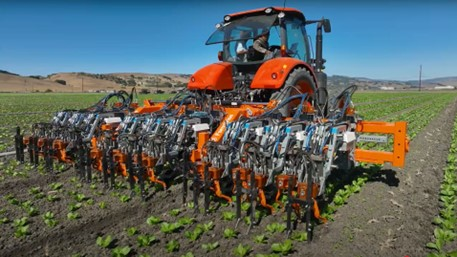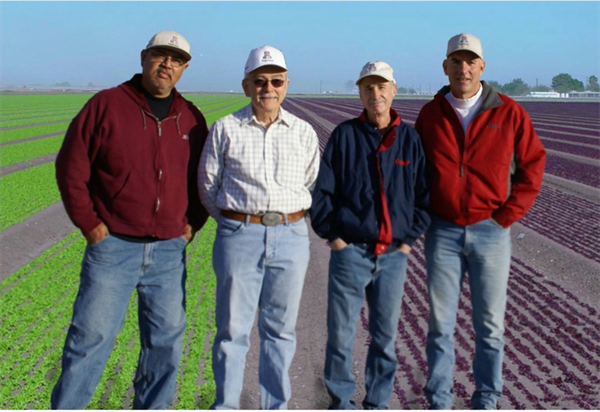
Chile (Capsicum annuum) is an important crop in the desert Southwest. The Capsicum annuum species is the most common group of chiles that we encounter and these chiles are common in our southwestern diet. The New Mexico type chile (aka, Anaheim) is the most common type of chile crop in the desert Southwest including production ares in southeastern Arizona, southern New Mexico, west Texas, and northern Chihuahua, Mexico.
There are five domesticated species of chile peppers. 1) Capsicum annuum is probably the most common to us and it includes many common varieties such as bell peppers, wax, cayenne, jalapeños, Thai peppers, chiltepin, and all forms of New Mexico chile. 2) Capsicum frutescens includes malagueta, tabasco, piri piri, and Malawian Kambuzi. 3) Capsicum chinense includes what many consider the hottest peppers such as the naga, habanero, Datil, and Scotch bonnet. 4) Capsicum pubescens includes the South American rocoto peppers. 5) Capsicum baccatum includes the South American aji peppers (Guzman and Bosland, 2017). Some examples are shown in Figure 1 and some other chile pepper species as well.

Figure 1. Capsicum annuum pod types include A) Asian, B) Cayenne, C) Chile de Arbol,
D) Chiltepin, E) Hungarian Paprika, F) Jalapeño, G) New Mexican, and H) Poblano. A
Capsicum baccatum pod type is I) Aji. Capsicum chinense pod types are J) Bhut Jolokia,
K) Habanero, and L) Scorpion. A Capsicum pubescens pod type is M) Rocoto and a
Capsicum frutescens pod type is N) Tabasco. Source: Guzman and Bosland, 2017.
Crop Phenology
Understanding of the basic stages of plant growth in relation to time or age (crop phenology) and basic crop needs, i.e., water and nutrients, is an important part of crop management. There is a strong relationship among the phenological, morphological and physiological changes that occur with crop development. Understanding what is going on physiologically within a plant at various stages of growth and development is critical in efficiently managing crop inputs such as water and plant nutrients.
Plants respond to environmental conditions and temperature is the primary developmental force in plant development when water is not limiting. Heat units (HUs) can be used as a good measure of “thermal time” that drives plant development. Thus, HUs can be used as a management tool for predicting and identifying stages of growth and physiological needs. We can then use that information for more efficient timing of irrigation and nutrient inputs to crop and pest management strategies. Figures 2 and 3 describe the basic HU concept with upper and lower thresholds.
Crop phenology models describe how crop growth and development are impacted by weather and climate and provide an effective way to standardize crop growth and development among different years and across many locations (Baskerville and Emin, 1969; Brown, 1989).
People still use days after planting to estimate stages of crop development but HUs are more accurate and reliable. As a result, HU based methods of predicting and tracking crop growth can be more consistently and effectively used in crop production systems.
The use of HU-based phenology models is most applicable in irrigated crop production systems where water is a non-limiting factor. Water stress will alter phenological plant development and it is a major source of variation irrespective of temperature conditions.
Chiles are a warm season, perennial plant with an indeterminant growth habit that we grow and manage as an annual crop. The fruiting cycle begins at the crown stage of growth (Figures 4 and 5) and continues until the plant reaches a point of “cut-out” with a hiatus in blooming as the plant works to mature the chile fruit that the crop has set and established.
Figure 6 describes the basic phenological baseline for New Mexico – type chile and was developed from field studies conducted in New Mexico and Arizona (Silvertooth et al., 2010 and 2011; Soto et al., 2006; and Soto and Silvertooth, 2007).
Heat units accumulated after planting (HUAP) for any date of planting to the present date can be easily accessed in the Arizona Meteorological Network (AZMET) website.
In the 2025 season, New Mexico-type chiles in southeastern Arizona experienced a good start to the season after planting. In tracking a set of New Mexico-type chile varieties, their development is tracking very closely to the HU model shown in Figure 6. For example, crown formation and first flowers have been consistently observed at approximately 1,300 – 1,450 HUAP among numerous New Mexico type varieties in southeastern Arizona this season. Many fields are progressing through peak bloom consistent with Figure 6 and early set fruit is maturing nicely as well.

Figure 2. Typical relationship between the rate of plant growth and development and
temperature. Growth and development cease when temperatures decline below the
lower temperature threshold (A) or increase above the upper temperature threshold (C).
Growth and development increases rapidly when temperatures fall between the lower
and upper temperature thresholds (B).

Figure 3. Heat unit calculation with the sine curve method using upper and lower
temperature thresholds (Brown, 1989). The 86/55 ºF thresholds are used, consistent
with most warm season crops.
Figure 4. Photo of a New Mexico chile plant with crown formation and the first fruiting
branch shown withing the red circle.
Figure 5. Photo of a New Mexico chile plant with crown formation and early first fruiting
branch development. Source: Courtesy of Mr. Ed Curry, Pearce, AZ.

Figure 6. Basic phenological guideline for irrigated New Mexico-type chiles.
References
Baskerville, G.L. and P. Emin. 1969. Rapid estimation of heat accumulation from maximum and minimum temperatures. Ecology 50:514-517.
Bosland, P.W., E.J. Votava, and E.M. Votava. 2012. Peppers: Vegetable and spice capsicums. Wallingford, U.K.: CAB Intl.
Brown, P. W. 1989. Heat units. Bull. 8915, Univ. of Arizona Cooperative Extension, College of Ag., Tucson, AZ.
Guzmán, I. and P.W. Bosland. 2017. Sensory properties of chile pepper heat - and its importance to food quality and cultural preference. Appetite, 2017 Oct1;117:186-190. doi: 10.1016/j.appet.2017.06.026.
Silvertooth, J.C., P.W. Brown, and S. Walker. 2010. Crop Growth and Development for Irrigated Chile (Capsicum annuum). University of Arizona Cooperative Extension Bulletin No. AZ 1529
Silvertooth, J.C., P.W. Brown and S. Walker. 2011. Crop Growth and Development for Irrigated Chile (Capsicum annuum). New Mexico Chile Association, Report 32. New Mexico State University, College of Agriculture, Consumer and Environmental Science.
Soto-Ortiz, Roberto, J.C. Silvertooth, and A. Galadima. 2006. Crop Phenology for Irrigated Chiles (Capsicumannuum L.) in Arizona and New Mexico. Vegetable Report, College of Agriculture and Life Sciences Report Series P-144, November, University of Arizona.
Soto-Ortiz, R. and J.C. Silvertooth. 2007. A Crop Phenology Model for Irrigated New Mexico Chile (Capsicum annuum L.) The 2007Vegetable Report. Jan 08:104-122.
I hope you are frolicking in the fields of wildflowers picking the prettiest bugs.
I was scheduled to interview for plant pathologist position at Yuma on October 18, 2019. Few weeks before that date, I emailed Dr. Palumbo asking about the agriculture system in Yuma and what will be expected of me. He sent me every information that one can think of, which at the time I thought oh how nice!
When I started the position here and saw how much he does and how much busy he stays, I was eternally grateful of the time he took to provide me all the information, especially to someone he did not know at all.
Fast forward to first month at my job someone told me that the community wants me to be the Palumbo of Plant Pathology and I remember thinking what a big thing to ask..
He was my next-door mentor, and I would stop by with questions all the time especially after passing of my predecessor Dr. Matheron. Dr. Palumbo was always there to answer any question, gave me that little boost I needed, a little courage to write that email I needed to write, a rigid answer to stand my ground if needed. And not to mention the plant diagnosis. When the submitted samples did not look like a pathogen, taking samples to his office where he would look for insects with his little handheld lenses was one of my favorite times.
I also got to work with him in couple of projects, and he would tell me “call me John”. Uhh no, that was never going to happen.. until my last interaction with him, I would fluster when I talked to him, I would get nervous to have one of my idols listening to ME? Most times, I would forget what I was going to ask but at the same time be incredibly flabbergasted by the fact that I get to work next to this legend of a man, and get his opinions about pest management. Though I really did not like giving talks after him, as honestly, I would have nothing to offer after he has talked. Every time he waved at me in a meeting, I would blush and keep smiling for minutes, and I always knew I will forever be a fangirl..
Until we meet again.
Founded in 2016, FarmWise has been at the forefront of AI based weeding technologies for nearly a decade. Over this time, the company has raised over $65 million in capital. In 2023, the company launched their flagship machine, Vulcan - a 21’ wide automated in-row smart cultivator for vegetable crops, priced at $645,000 (Fig. 1). In a surprising announcement just two weeks ago, FarmWise stated that the company was going through a business restructuring and will cease operations in the coming weeks. The bottom line for the decision was that despite having a field-tested automated weeding machine that reduces hand weeding labor costs, the company has not been able to reach profitability with the resources on hand. Moving forward, the company says that they are actively pursuing strategic opportunities including acquisition, partnerships and technology transfer to ensure the Vulcan technology lives on. During the transition, their number one priority is supporting current customers.
For insightful details on the need for restructuring and FarmWise’s plans going forward, you can refer to articles from The Packer and AgFunderNews.

Fig. 1. FarmWise’s automated in-row smart cultivator, the Vulcan, operating in Salinas,
CA. (Photo credit: FarmWise, Santa Clara, CA)
Reference to a product or company is for specific information only and does not endorse or recommend that product or company to the exclusion of others that may be suitable
In 2010 we started publishing the Arizona Vegetable IPM Updates to a small number of friends. It was embraced by the community because of contributions from Mike Matheron, John Palumbo and Barry Tickes in the Plant Pathology, Entomology and Weed Science areas. Mike, John and Barry are the original IPM dudes.

I was honored to be part of the team editing and sending the Newsletter for almost
16 years.

This is my last update, and I would like to thank the UA team and the agricultural community for the opportunity to work with you.
To better support our stakeholders with pest management, we are launching an Insecticide Resistance Monitoring Program in Calvin’s Lab. This initiative will include seasonal insecticide efficacy bioassays using the most commonly used insecticides. We will target key pests of major crops grown in Arizona, with a particular focus on those affecting vegetables and citrus crops.
A major goal of this program is to establish baseline susceptibility data for Plinazolin’s target pests in vegetables and citrus crops. This will enable us to monitor potential changes in susceptibility over time and make informed, timely adjustments to pest control strategies.
Insecticide resistance monitoring is a critical component of Integrated Pest Management (IPM). Understanding the baseline susceptibility of insect pests is essential for early detection of resistance and the long-term success of new insecticide modes of action. It is especially important to gather this data for Plinazolin before its widespread adoption in our region.
To support this effort, we will collect insects from vegetable- and citrus-growing regions throughout Arizona. Your collaboration is essential. We will reach out to request access to field sites where we can collect target insect populations. Additionally, we encourage you to contact us directly if you experience insecticide control failures or suspect resistance in your fields.
Our current target pests include:
• Diamondback moth
• Beet armyworm
• Cabbage looper
• Western flower thrips
• Citrus thrips
• Aphids
• Whiteflies
Please let us know if there are additional pests you would like us to consider.
Thank you for your continued support. We look forward to working with you to address Arizona’s most pressing pest management challenges.In Yuma's arid agricultural landscape, selecting the right cover crops can significantly influence soil health, water management, and overall sustainability. Two notable options gaining attention among growers are Sudan grass and Sesbania. Sudan grass, a warm-season annual grass, is widely valued in Yuma for its ability to rapidly establish, providing excellent soil protection against erosion and wind. Its extensive root system enhances soil structure, boosts organic matter, and improves moisture retention, crucial for subsequent crops grown in desert conditions. Sesbania, a fast-growing legume, offers additional benefits. It excels at fixing atmospheric nitrogen, naturally enriching the soil and reducing the need for synthetic nitrogen fertilizers. Its deep taproot system penetrates compacted soil layers, improving water infiltration and reducing salinity levels, a common challenge in Yuma's agriculture.
Which Cover Crop Should You Choose?
The decision between Sudan grass and Sesbania depends largely on specific farm goals and challenges. If rapid establishment, erosion control, and increased organic matter are primary concerns, Sudan grass is an excellent choice. However, if the goal is to address soil fertility, nitrogen fixation, and salinity issues, Sesbania may be more beneficial. Using either Sudan grass or Sesbania as a cover crop in Yuma promotes healthier soils and supports sustainable farming practices, benefiting growers economically and environmentally. Considering these cover crops can be a strategic move toward enhanced agricultural productivity and long-term soil health in the region.